Alien Nummo were Depicted as Catfish
Updated June 2023
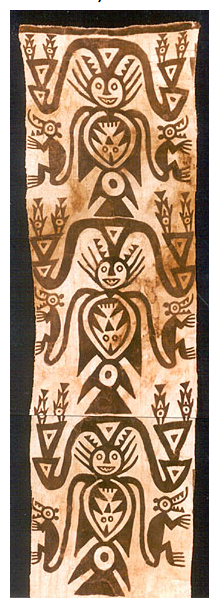 Peruvian TextilePainted textile, Chachapoyas Area, Abisco or Pajaten culture, 900-1400 By Unknown author - Unknown source, Public Domain, https://commons.wikimedia .org/w/index.php?curid= 39587788 |
I believe the fish tails and the lines on top of the fish heads on this Chachapoyas area textile, dated 900-1400 from the Abisco or Pajaten cultures of Peru, are associated with Dogon depictions of the alien Nummo. Dogon drawings of the Nummo appear with similar lines on the head to indicate the barbs of the Nummo, who were a type of catfish.Dorey, Day of the Fish p.100
The smaller fish shown inside the fish stomachs are also relevant because in regenerating Lébé, the Master (Mistress) of Speech (Seventh Nummo Ancestor) was believed to have first swallowed and then regurgitated Lébé. This was to indicate that the DNA from the Seventh Ancestor was used in the regeneration of Lébé, considered the mother of humanity. A Dogon drawing depicts this event.
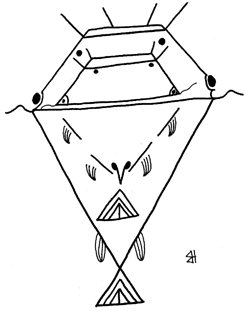 Lébé SwallowedDorey, The Rose p. 10, Figure 1-4 |
This drawing shows the Master (Mistress) of Speech as a catfish with Lébé, also depicted as a catfish inside her.Dorey, The Rose p. 10
The horns on the head of the three figures from the Peruvian textile may signify the Nummos' horns because when they were in their spaceships, they were known as "Celestial Rams". The Dogon elder Ogotemmêli told how the "Ram" had the power of movement once it had risen into the heavens. When it moved in the clouds, he said it left a track of four colours that looked like a rainbow.Dorey, The Master (Mistress) of Speech p. 23
The monkeys that appear as fish hands on the Chachapoyas Area textile may have the same meaning as the Dogon white monkey mask, known as the "Singe Blanc" (White Monkey).Marcel Griaule, Masques Dogons p. 461
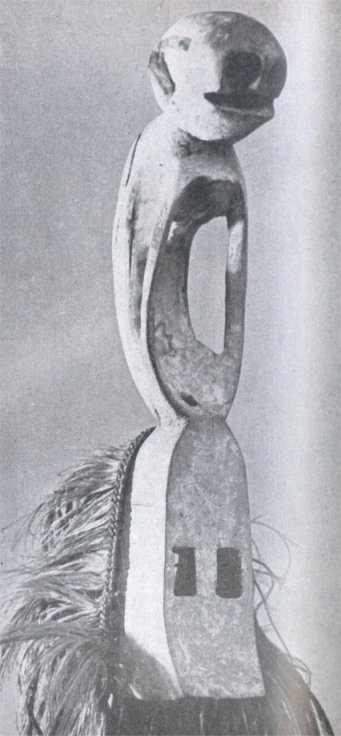 Dogon White Monkey MaskMarcel Griaule, Masques Dogons p. 460 |
In the Dogon religion, the white and black monkey masks were associated with the Celestial Smith (Jackal figure) and the stolen fire. This is a picture of the White Monkey (Singe Blanc) mask from Ireli, taken during Griaule's 1930s expedition.Marcel Griaule, Masques Dogons p. 460
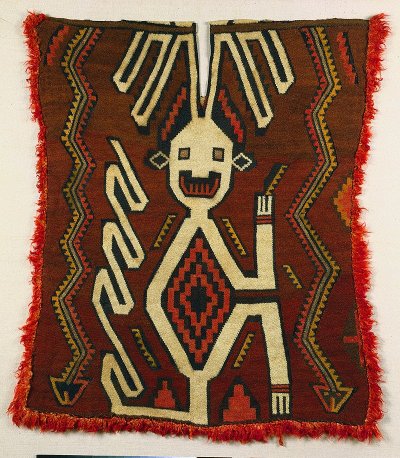 White Monkey TunicThe Norweb Collection by https://clevelandart.org /art/1940.514, CC0, https://commons.wikimedia.org /w/index.php?curid= 76004987 |
A white monkey appears on this tunic from the Paracas culture of Peru found on the South Coast in the Ica Valley dated from 400 - 200 BCE. The dual serpents beside the monkey are a symbol of the alien Nummo, who were "twins" and identified with serpents.Dorey, Day of the Fish p. 118
"The monkey-like tail as well as head appendages mark the creature as supernatural". According to the Cleveland Art Museum, this tunic is rare, made not on a loom but rather by working the yarns into loops with a needle. It is made entirely with camelid fiber from one of the four camels (camelids) native to the Andes Mountains—the alpaca and llama, both domesticated, and the wild guanaco and vicuña.https://www.clevelandart.org/art/1940.514 The Paracas culture existed from about 800 BCE to about 100 BCE.https://en.wikipedia.org/wiki/Paracas_culture
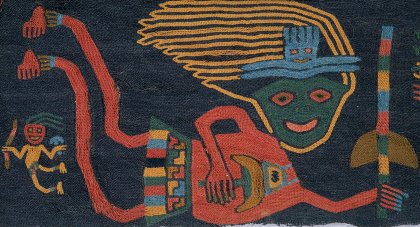 Paracas Textile FragmentBequest of Arthur M. Bullowa, 1993, Metropolitan Museum of Art, https://commons.wikimedia. org/w/index.php?curid= 57853681 |
The monkeys may also be associated with the figure carrying the hammer on this Paracas border textile fragment. I believe that this Paracas fragment, dated from 450 to 175 BCE, may be depicting the Jackal or Celestial Smith figure. He had two serpent legs in comparison to the Nummo and Eight Ancestors, who had a single fish tail. He is associated with the black and white monkey masks and the stolen fire. On his journey through space, the Smith held a hammer and bow in his hand. He was associated with the first human.Dorey, The Master (Mistress) of Speech p. 39
The Paracas culture existed from around 800 BCE to 100 BCE in the Ica Region of modern Peru. The people had extensive knowledge of irrigation and water management and made significant contributions to the textile arts.https://en.wikipedia.org/ wiki/Paracas_culture
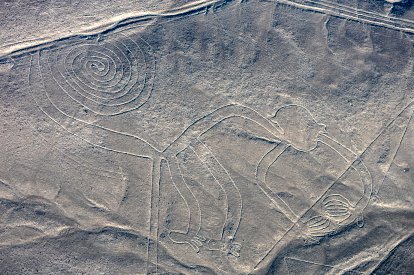 "Monkey" by Diego DelsoBy Diego Delso, CC BY-SA 4.0, https://commons.wikimedia .org/w/index.php? curid=42787825 Peru. |
The picture above is an aerial view of the "Monkey", one of the most popular geoglyphs of the Nazca Lines.https://en.wikipedia. org/wiki/Nazca_Lines The Nazca Lines are a group of very large geoglyphs made in the soil of the Nazca Desert in southern Peru created between 500 BCE and 500 CE, and which can best be discerned from the sky. I believe this monkey is associated with the monkeys seen on the Chachapoyas area textile and the Paracas tunic.
The Nazca culture (also Nasca) flourished from 100 BCE to 800 CE beside the southern coast of Peru in the river valleys of the Rio Grande de Nazca drainage and the Ica Valley.https://en.wikipedia. org/wiki/Nazca_culture
A tunic from the Wari-Nazca culture depicts dual catfish and is referred to in a previous article on the Kuelap Fortress in Peru. The Wari inhabited the south-central Andes and coastal area of modern-day Peru, from about 500 to 1000 AD and were known for their textiles.https://en.wikipedia .org/wiki/Wari_culture
For more information on the Dogon religion refer to my books, The Master (Mistress) of Speech, The Nummo, Day of the Fish and The Rose.